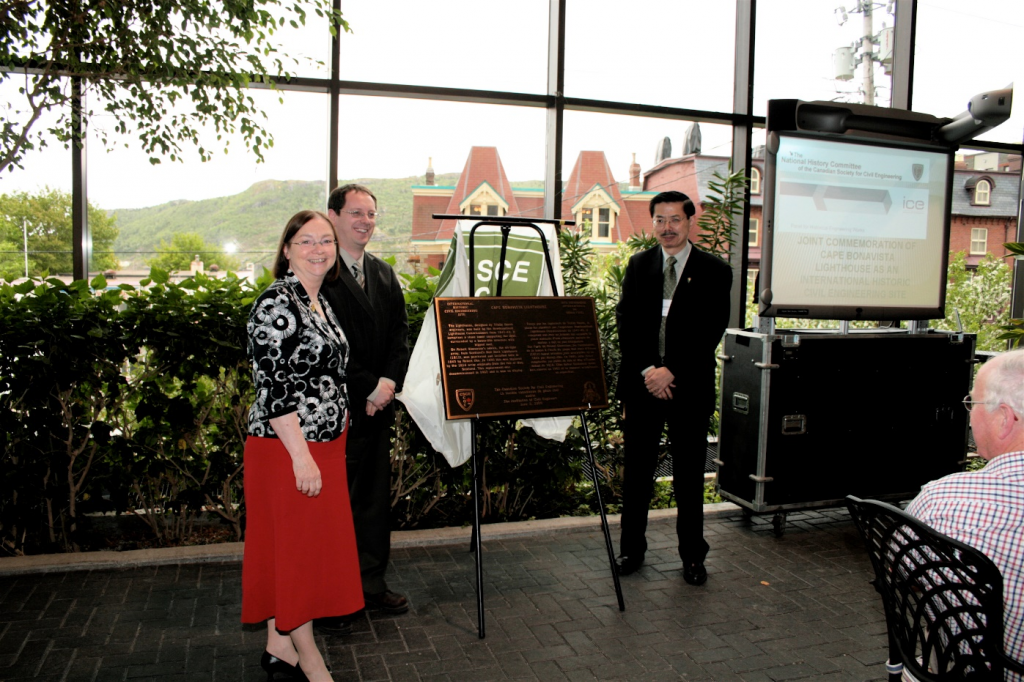This International Historic Civil Engineering Site was commemorated jointly by the Canadian Society for Civil Engineering and the Institution of Civil Engineers.

Site Location: Lat.: 48° – 42’ – 5” N; Long.: 53° – 5’ – 7” W. (GPS: 48.7014385,-53.0852568). From the junction of NL 235 (Station Road) and NL 230 (Confederation Drive) in Bonavista, proceed north on Confederation Drive for 1.1 km, noting that it turns sharply left at Lench Lane. Turn right (north) onto Cape Shore Road, and proceed 5.8 km to the lighthouse.
Plaque Location: The plaque is currently in storage at the Cape Bonavista Lighthouse.
Description: The Lighthouse, designed by Trinity House engineers, was built by the Newfoundland Lighthouse Commissioners from 1841-43. It comprises a stone tower supporting the light, surrounded by a house-like structure with a hipped roof. On Robert Stevenson’s advice, the oil-light array, from Scotland’s Bell Rock Lighthouse (1811), was purchased and installed here in 1843 by Robert Oke. In 1895 this was replaced by the 1816 array originally from the Isle of May, Scotland. This replacement was decommissioned in 1962 and is now on display at the on-site museum.
Historic Significance: The Cape Bonavista light station, built to mark the entrances to Bonavista and Trinity bays and to aid mariners headed for Labrador, is the fourth-oldest lighthouse in Newfoundland. Robert Stevenson was chief engineer of the Northern Lighthouse Trust, a leading member of four generations of Stevensons that built lasting lighthouses that were subjected to extremely difficult conditions on the coasts of Scotland. Robert Oke, who served as the first Chief Inspector of the Newfoundland Lighthouse Service. After nearly 120 years of service, the Cape Bonavista lighthouse was replaced by an electric light on a nearby steel skeleton tower.

Plaque Wording: International Historic Civil Engineering Site. CAPE BONAVISTA LIGHTHOUSE. The Lighthouse, designed by Trinity House engineers, was built by the Newfoundland Lighthouse Commissioners from 1841-43. It comprises a stone tower supporting the light, surrounded by a house-like structure with a hipped roof. On Robert Stevenson’s advice, the oil-light array, from Scotland’s Bell Rock Lighthouse (1811), was purchased and installed here in 1843 by Robert Oke. In 1895 this was replaced by the 1816 array originally from the Isle of May, Scotland. This replacement was decommissioned in 1862 and is now on display. CSCE. The Canadian Society for Civil Engineering and The Institution of Civil Engineers.
Site Historique International de Génie Civil. CAPE BONAVISTA LIGHTHOUSE. Conçu par les ingénieurs de Trinity House, le phare fut construit par l’organisme Newfoundland Lighthouse Commissioners en 1841-43. Il comprend un tour en briques qui supporte le phare entourée d’une charpente typique de maison á toit en pan triangulaire. Sur l’avis de Robert Stevenson, les composantes de la lampe á l’huile du phare Bell Rock d’Écosse (1811) furent achetées pus assemblées ici en 1843 par Robert Oke. En 1895, ells furent remplacées par celles de Isle of May d’ Écosse datant de 1816. Elles furent finalement mises hors service en 1962 et se trouvent actuellement en exposition. SCGC. La société canadienne de genie civil et The Institution of Civil Engineers.
Plaque Unveiling Ceremony: (July 2, 2009)

Link to Online Documentation:
Canada’s Historic Places, “Cape Bonavista Lighthouse”.
Virtualmuseum.ca, “A Guiding Light – Cape Bonavista Lighthouse Historic Site”.